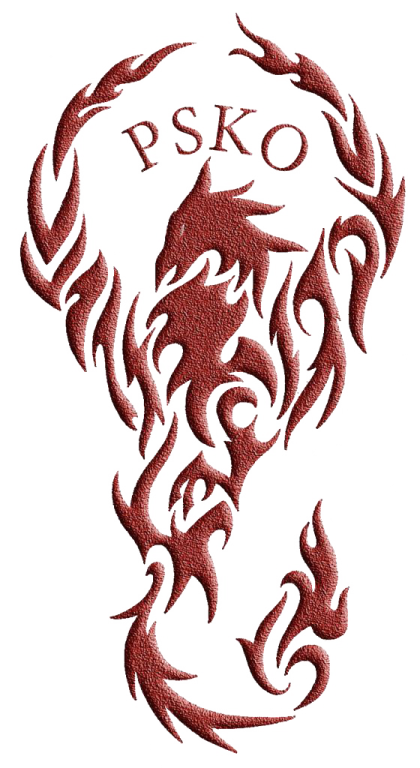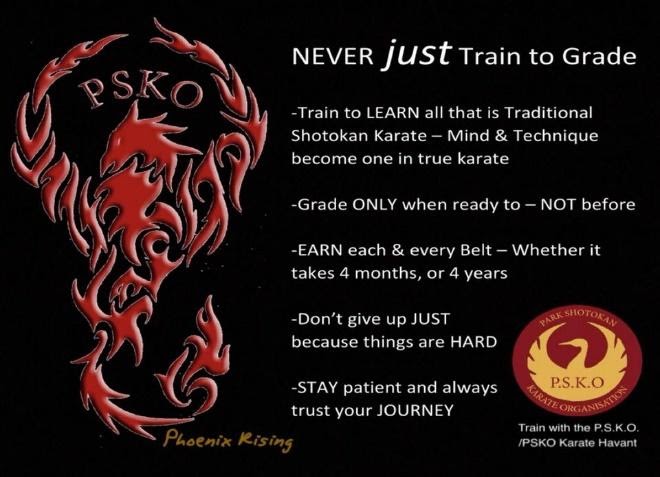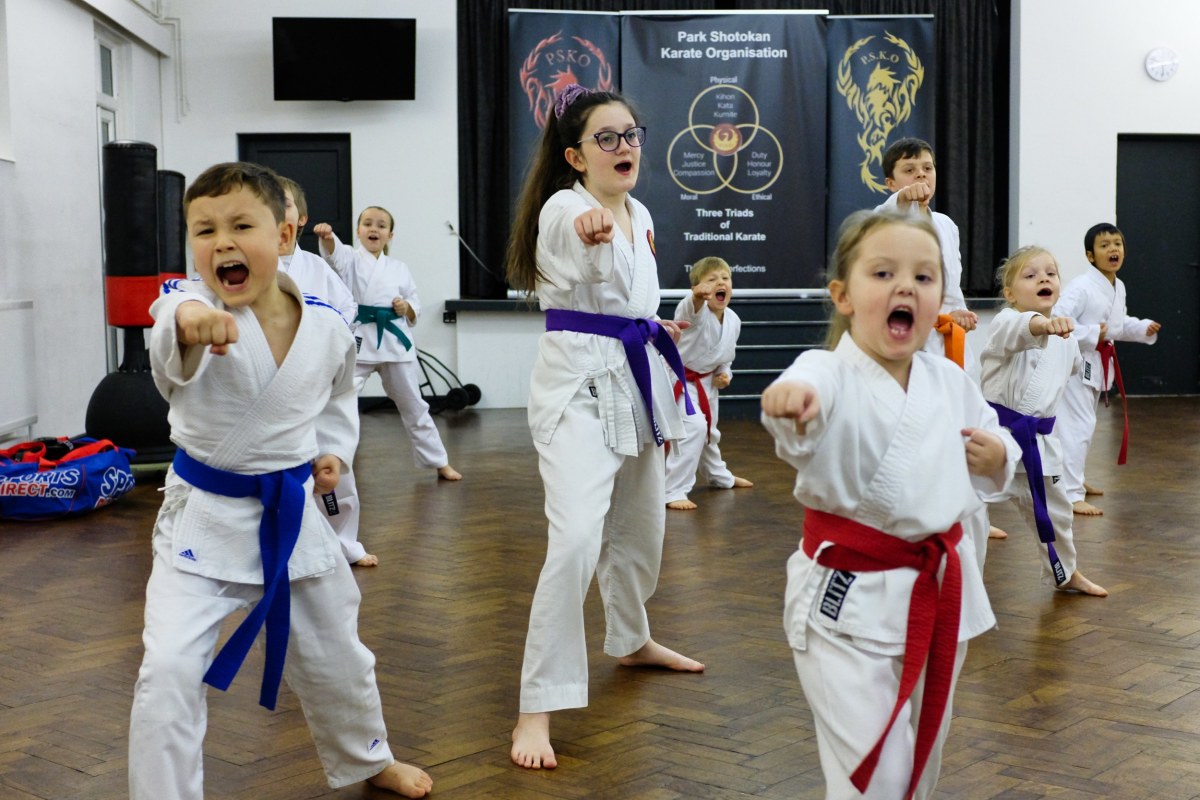The Phoenix

The Phoenix was the name of the first location of the P.S.K.O. club run by Sensei Fletch from the 1980’s through to the early 2000’s. The Phoenix symbol was then, and is now, very much the heart and soul of the Organisation.
The Phoenix represents the cycle of life, the old that turns into the new. Rising above adversity, it is the change, hope and growth that continues throughout life.
Dojo Rules
- No eating, drinking, chewing gum or smoking in the Dojo.
- No jewellery to be worn whilst training.
- Bow upon entering and leaving the Dojo.
- Show absolute obedience to your instructors during training.
- Long hair must be tied back.
- When resting sit cross-legged.
- Do not be late for training.
- Call your instructor Sensei (pronounced Sen-say).
- Do not leave the class without permission from the instructor.
- Respect to all other students must be shown at all times.
- Misuse of one’s Karate knowledge may result in temporary (or permanent) suspension from the PSKO.
Grading

Gradings are held every 4 months and are open to all club members. They offer a chance to measure progress for both the student and their instructors. Here is the belt system used by the club:
| 10th Kyu (Beginners) | White |
| 9th Kyu | Red |
| 8th Kyu | Yellow |
| 7th Kyu | Orange |
| 6th Kyu | Green |
| 5th Kyu | Blue |
| 4th Kyu | Purple |
| 3rd Kyu | Brown |
| 2nd Kyu | Brown + 1 white stripe |
| 1st Kyu | Brown + 2 white stripes |
| 1st Dan (Shodan) | Black |
Depending on their attendance and proficiency students from 10th Kyu to 2nd Kyu are eligible to grade every 4 months. 1st Kyu and 1st Dan grades require a minimum of 8 months training each. After this further Dan grades are held less regularly and involve intensive training over a period of years. For example, at least 2 years of training is required for 2nd Dan, 3 years for 3rd Dan and so on. Nobody is guaranteed to pass a grading!
Gradings comprise the three physical key elements of Karate: Kihon, Kata and Kumite. These are assessed according to the grading syllabus devised by the instructors. Gradings become increasingly more challenging as the student progresses and are there to offer a unique challenge to all who participate. All students are encouraged to take part however they are not compulsory.
Student of the Month

At the end of every Month we take the opportunity to remember that continuous effort and individual progress is an important part of our student’s journey to learning Shotokan Karate. We recognize and celebrate those individuals who demonstrate this effort during training and show good character traits such as teamwork, communication, respect, integrity and perseverance.
Terminology
Karate is a Japanese Martial Art, so students are required to learn the Japanese terminology. This will happen naturally as they progress in their classes, but here is a list of common terms and their translations:
| Japanese | English | Japanese | English |
|---|---|---|---|
| General | |||
| Dojo | Training Hall | Dojo Kun | Dojo code |
| Sensei | Instructor | Seiza | Kneel |
| Rei | Bow | Yoi | Ready |
| Hajime | Begin | Mawatte | Turn |
| Yame | Finish | Gi | Karate Suit |
| Obi | Belt | Kime | Focus |
| Kiai | Shout | Kihon | Basic techniques |
| Kata | Forms | Kumite | Sparring |
| Oss | Respectful acknowledgement | Jodan | Head |
| Chudan | Middle body | Gedan | Lower body |
| Counting | |||
| Ichi | One | Ni | Two |
| San | Three | Shi | Four |
| Go | Five | Roku | Six |
| Shichi | Seven | Hachi | Eight |
| Kyu | Nine | Ju | Ten |
| Dachi | Stances | ||
| Zenkutsu dachi | Front stance | Kiba dachi | Side / Horse stance |
| Shiko dachi | Open leg / Sumo stance | Kokutsu dachi | Back stance |
| Uke | Blocks | ||
| Gedan barai | Downward block | Age uke | Rising block |
| Soto uke | Outside block | Uchi uke | Inside block |
| Shuto uke | Knife hand block | Tate Shuto uke | Vertical knife hand block |
| Nagashi uke | Sweeping block | Haishu uke | Back hand block |
| Empi uke | Elbow block | Juji uke | X block |
| Morote uke | Augmented block | Kakewake uke | Wedge block |
| Tsuki | Punches | ||
| Oi tsuki | Stepping punch | Kizami tsuki | Front hand punch |
| Gyaku tsuki | Reverse hand punch | Kagi tsuki | Hook punch |
| Ren tsuki | Two punch combo | Sanbon tsuki | Three punch combo |
| Uchi | Strikes | ||
| Age empi uchi | Rising elbow strike | Yoko empi uchi | Side elbow strike |
| Mawashi empi uchi | Roundhouse elbow strike | Ushiro empi uchi | Reverse elbow strike |
| Tate empi uchi | Downward elbow strike | Shuto uchi | Knife hand strike |
| Uraken uchi | Back fist strike | Tetsui uchi | Hammer fist strike |
| Nukite | Spear hand thrust | Teisho uchi | Palm heel strike |
| Haito uchi | Ridge hand strike | ||
| Geri | Kicks | ||
| Mae geri | Front kick | Yoko geri keage | Side snap kick |
| Yoko geri kekomi | Side thrust kick | Mawashi geri | Roundhouse kick |
| Ushiro geri | Reverse kick | Hiza geri | Knee kick |
| Ren geri | Kicking combos | ||
| Kumite | Sparring | ||
| Sanbon kumite | Three step sparring | Gohon kumite | Five step sparring |
| Kihon Ippon Kumite | Basic one step sparring | Jiyu Ippon Kumite | Semi-freestyle sparring |
| Kaishi Ippon Kumite | Reaction sparring | Jiyu Kumite | Freestyle sparring |

